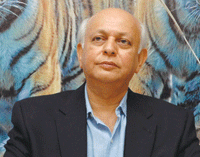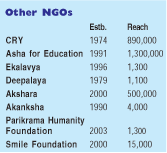If despite middle class apathy and inertia, and pervasive corruption in government-provided education, some progress has been made in moving public education from the periphery of national consciousness towards the centre, a substantial share of the credit needs to be given to the country’s estimated 20,000 education NGOs, which have consistently pressed the case for education reform and upgradation. India’s expanding number of education NGOs are not only running informal learning centres and schools to supplement the Central and state governments’ half-hearted attem-pts at providing meaningful school and higher education, they’ve also made valuable contributions towards impro-ving the quality of education dispensed in India’s 1.25 million government schools. EW presents profiles of India’s most influential and promising education NGOs.
Pratham
.gif) Promoted in 1994 with a mandate to ensure every child is in school and learning well, Pratham is one of India’s largest and most influential education NGOs. Operating in 17 states, it reaches 3 million children through its supplementary reading and basic maths programmes. Its path-breaking Annual Status of Education Report (ASER, first published in 2005) is the country’s first and only independent audit report of actual learning outcomes of primary school children in rural India. According to ASER 2010, the quality of education dispensed in rural primaries is so poor that almost half (46.6 percent) the students in class V are unable to exhibit the learning and comprehension levels they should have attai-ned in class II. Pratham is also the first and only education NGO to raise $8 million (Rs.40 crore) annually from the Indian diaspora abroad.
Promoted in 1994 with a mandate to ensure every child is in school and learning well, Pratham is one of India’s largest and most influential education NGOs. Operating in 17 states, it reaches 3 million children through its supplementary reading and basic maths programmes. Its path-breaking Annual Status of Education Report (ASER, first published in 2005) is the country’s first and only independent audit report of actual learning outcomes of primary school children in rural India. According to ASER 2010, the quality of education dispensed in rural primaries is so poor that almost half (46.6 percent) the students in class V are unable to exhibit the learning and comprehension levels they should have attai-ned in class II. Pratham is also the first and only education NGO to raise $8 million (Rs.40 crore) annually from the Indian diaspora abroad.
Excerpts of an interview with Madhav Chavan, co-founder and chief executive of Pratham.
How satisfied are you with the pace of growth of Pratham?
I think we have grown fairly well but we have many weaknesses, consi-dering the huge challenges of Indian education. We know how to mobilise volunteers and villagers or slum-dwellers to work on projects. However, we have not been able to organise them into a powerful force to impact governance. We know how to teach children basic skills of reading, writing, arithmetic up to say, class IV but as an organisation we do not know how to teach higher levels of math and science. Since we largely depend on village youth to deliver basic skills to children, their weaknesses in terms of knowledge and skills are our weaknesses too.
How receptive is the Central or state government to Pratham’s interventions?
The government seems to be a monolith, but it’s not. It is run by people with differing views and ideologies. We believe that in a country that is so educationally backward, holistic education is a distant dream although it has to be achieved. At this time, when 50 percent of children do not have the basic skills to meaningfully negotiate education after class VI, there is a need to focus on some broad competencies nationally and achieve them. But many educationists differ with us and some of them advise governments against such strategies described as minimalist.
This is largely true of the Centre. However, in the states the picture is different. There are swelling streams within state governments in favour of measurement and evidence-based learning.
What are your future growth and development plans?
We are moving on two new fronts. One, we are developing initiatives that will leverage new technology. A second development is in the area of youth skilling. We have trained hundreds of thousands of volunteers in short bursts of training for our initiatives. Now we want to combine skilling for employ-ment-readiness and entrepreneurship with volunteering to teach. Finally, we are also looking at ways of making our initiatives at least partially financially sustainable so that our growth is not threatened by financial crises.
Azim Premji Foundation
.gif) During the past 13 years since the Azim Premji Foundation (APF, regd.1998) — promoted by Bangalore-based IT billionaire Azim Premji — began its interventions in primary education, the foundation’s progra-mmes have impacted 2.5 million children in 20,000 government schools in 13 states. Its most ambitious project — the Azim Premji University (APU) — which received a hugely generous $2 billion (Rs.10,000 crore) endowment from Premji — got off the ground in July with the admission of its first batch of 97 students pursuing their Masters in education and development. With APU promising to train and develop competent professionals to address and find innovative solutions to India’s diverse education challenges, the foundation is all set to scale up its initiatives in public education.
During the past 13 years since the Azim Premji Foundation (APF, regd.1998) — promoted by Bangalore-based IT billionaire Azim Premji — began its interventions in primary education, the foundation’s progra-mmes have impacted 2.5 million children in 20,000 government schools in 13 states. Its most ambitious project — the Azim Premji University (APU) — which received a hugely generous $2 billion (Rs.10,000 crore) endowment from Premji — got off the ground in July with the admission of its first batch of 97 students pursuing their Masters in education and development. With APU promising to train and develop competent professionals to address and find innovative solutions to India’s diverse education challenges, the foundation is all set to scale up its initiatives in public education.
Dileep Ranjekar, chief executive of APF, was interviewed in Bangalore.
What is the focus of APF’s activities?
For over a decade now, APF has been working in the primary education sector. It has partnered with state governments across India to pilot initiatives that have the potential for systemic reform to enhance the quality of elementary education within government-run schools. Drawing upon this rich experience at the grassroots level, the foundation has extended, expanded and intensified its work in four distinct areas: talent development, knowledge creation, building institutions and generating social pressure for elementary education.
The creation of strong institutions and robust institutional architecture is also essential for long-term sustainability. Thus we have established the following institutions to execute our vision: Azim Premji University; the Institute for Assessment and Accreditation; Azim Premji State and District Institutes of Learning and Development; and demons-tration schools.
What are APF’s collaborations with the state and Central government?
The foundation is focused on the following key areas while working with government:
Teacher education. Since inception, we have trained over 50,000 government school teachers in eight states.
Education leadership and management. We have developed 3,500 education functionaries in Karnataka, including school principals.
Examination reforms. Following our work in this area, eight districts in five states have changed the way they conduct examinations for students up to class V.
Technology in education. The foundation has created syllabus-based bi/trilingual multi-media content and is probably the largest developer of digital learning resources for classes III-VIII in 18, including four tribal, languages.
What are APF’s future growth and development plans?
By 2016, the Azim Premji University will enroll 4,000 full-time students instructed by 350 faculty, and train 500,000 existing teachers under its continuing education programmes. Moreover, the foundation will establish 50 district institutes, eight state initiatives and 200 demonstration schools by 2016.
AID India
.gif) A volunteer movement “promoting sustainable, equitable and just development”, Association for India’s Development (AID India, estb.1996) has 12 chapters across the country and 7,000 direct volunteers — from software professionals to casual labour — who participate in the NGO’s education, health and rural development programmes. Its flagship Eureka Child Education Project — a basic reading and maths improvement programme — has impacted 1 million children in 1,100 villages in Tamil Nadu, Bihar and Orissa. AID India’s 25 preschools and two primary schools have enroled 1,000 children in Tamil Nadu, while its livelihood and rural development project reaches 1,500 families in 70 villages in Orissa, Andhra Pradesh and Tamil Nadu.
A volunteer movement “promoting sustainable, equitable and just development”, Association for India’s Development (AID India, estb.1996) has 12 chapters across the country and 7,000 direct volunteers — from software professionals to casual labour — who participate in the NGO’s education, health and rural development programmes. Its flagship Eureka Child Education Project — a basic reading and maths improvement programme — has impacted 1 million children in 1,100 villages in Tamil Nadu, Bihar and Orissa. AID India’s 25 preschools and two primary schools have enroled 1,000 children in Tamil Nadu, while its livelihood and rural development project reaches 1,500 families in 70 villages in Orissa, Andhra Pradesh and Tamil Nadu.
An alumnus of IIT-Madras and University of Maryland (USA), Dr. Balaji Sampath is founder-director of AID India. Excerpts from an interview:
What is the outstanding contribution of AID India?
Our most important direct contribu-tion is building the reading and arithmetic skills of over 1 million children from extremely poor families in village India. AID India’s Eureka reading and maths programmes have enabled children to improve their learning competencies and motivated them to continue their education. At a broader level, we have inspired hope and confidence among people that change is possible.
How satisfied are you with the pace of growth of AID India?
If I was asked this question 15 years ago, I would have said I’m dissatisfied and want things to move faster. But over the years, I have realised that quality is important. Therefore we have focused on steady growth to maintain the quality of our programmes.
How enabling are Central and state government policies for establishing your centres?
Though we have done a lot of work with government schools, I feel that both at the state and Central levels, governments feel threatened by independent NGOs. They are happy to deal with contract NGOs to whom they can disburse some funds and assign rigidly defined schemes to implement. But government does not want to engage with organisations which highlight gaps in their services and offer ideas to improve them. Instead of acknowledging that proven NGOs can complement govern-ment efforts in strengthening quality of education and health services for the poorest, the government is trying to push NGOs out of schools, ICDS, etc.
What are your future growth and development plans?
We hope to scale up our Eureka village education centres to 1,000 villages and over the next few years, expand it to 2,500 villages. Contiguously, we are planning campaigns to generate greater awareness and acceptance of the serious learning quality gaps faced by village children, and are pushing for systemic changes by focusing on improving the reading and math skills of primary children.
Teach For India
 Modelled on the highly-successful Teach For America programme founded by Wendy Kopp in 1989, Teach For India is a high-potential initiative under which outstanding college graduates and professionals commit two years to teach full-time in under-resourced schools in an effort to end “inequity in education”. An initiative of Teach to Lead, an NGO registered in 2008, Teach For India has placed 370 fellows (paid a monthly stipend of Rs.15,000 and housing allowance) in 122 schools in Mumbai, Pune and Delhi.
Modelled on the highly-successful Teach For America programme founded by Wendy Kopp in 1989, Teach For India is a high-potential initiative under which outstanding college graduates and professionals commit two years to teach full-time in under-resourced schools in an effort to end “inequity in education”. An initiative of Teach to Lead, an NGO registered in 2008, Teach For India has placed 370 fellows (paid a monthly stipend of Rs.15,000 and housing allowance) in 122 schools in Mumbai, Pune and Delhi.
Shaheen Mistri is the founder CEO of Teach For India and founder of Akanksha Foundation (estb.1991), which offers supplementary education to 3,500 underprivileged children in Mumbai and Pune.
What in your opinion, is the outstanding contribution of Teach for India?
The most outstanding contribution of Teach For India is that more and more of India’s bright young college gradu-ates and professionals are volunteering to spend two years in under-resourced classrooms, moving out of their comfort zones, and committing to bridge the education gap in India.
How satisfied are you with the pace of growth of Teach for India?
I am thrilled to see continuous and growing interest in our fellowship programme. From a cohort of 80 fellows in May 2009, we now have a total of 370 fellows teaching 12,000 children in 310 classrooms across 122 schools in Mumbai, Pune and Delhi.
Is the Central/state government receptive to your interventions in their schools?
The state governments of Maharashtra, Delhi, and now Andhra Pradesh and Tamil Nadu, have been very supportive of our initiative and understand that excellent education is the need of the hour. Our fellows teach in government and private schools in Mumbai, Pune and Delhi.
Future plans.
We hope to recruit graduate fellows in all the major cities within five years.
Hemendra Kothari Foundation
 Hemendra Kothari Foundation (HKF) is a Mumbai-based philant-hropic organisation focused on education, health and wildlife conservation. It was promoted in 2008 by Hemendra Kothari, former chairman of DSP Merrill Lynch who sold out to Merrill Lynch for $475 million in 2005 and Bank of America in 2009, and is currently chair-man of DSP Blackrock Management.
Hemendra Kothari Foundation (HKF) is a Mumbai-based philant-hropic organisation focused on education, health and wildlife conservation. It was promoted in 2008 by Hemendra Kothari, former chairman of DSP Merrill Lynch who sold out to Merrill Lynch for $475 million in 2005 and Bank of America in 2009, and is currently chair-man of DSP Blackrock Management.
In the financial year 2011-12, HKF is supporting NGOs working with over 100 government schools near Ranthambhore, Pench, Tadoba Andhari and Mudumalai tiger reserves. Moreover, HKF supports 21 schools run by the Nashik Education Society with an aggregate enrolment of 27,000 students and 750 teachers. HFK’s operations are directly supervised by Kothari and his Wharton-educated daughter Aditi.
Excerpts of an interview with Hemendra Kothari, chairperson of HKF.
What are the major objectives of HKF?
We are clearly focused on wildlife protection and environment conser-vation, education, health and heritage. In education, HKF is committed to encouraging best teaching practices, creating educational opportunities for children and youth in remote villages near tiger reserves, and helping schools become attractive hubs of learning through improvement of libraries, laboratories, and sanitation facilities.
What is the USP of HKF?
We go to places where most are reluc-tant to go, especially schools abutting forests. Another of HKF’s unique features is our investment in the development of knowledge resources, reflected in our support to teacher training programmes, upgrading libraries and computer-based teaching-learning. We are also open to supporting entrepr-eneurial ideas to galvanise primary, secondary and tertiary education.
How receptive are the Central and state governments to HKF’s interventions?
In our education initiatives in tiger reserves, local forest adminis-trations have been very supportive. We are quite sure the state and Central governments will be receptive to good models of community mobilisation and public-private partnerships for education development.
What are your future growth and development plans?
We hope to favourably impact and upgrade neglected communities living near forests. The impact will be in the form of steady outflow of employable human resources from forest areas to urban centres, and a reverse flow of prosperity. This will also stabilise the fragile environments in which tiger reserves and sanctuaries are located. Within five years, we also expect to support a few hundred model schools and technology-equipped communities of teachers, students and farmers.
